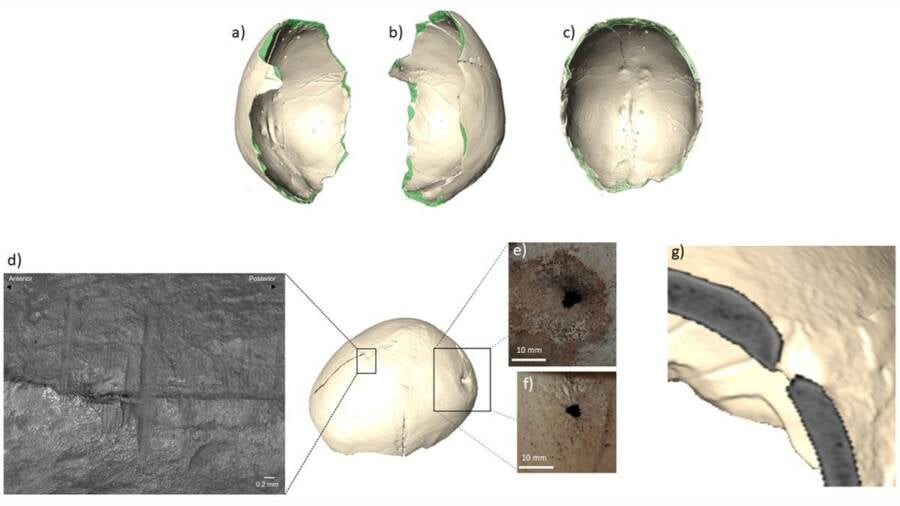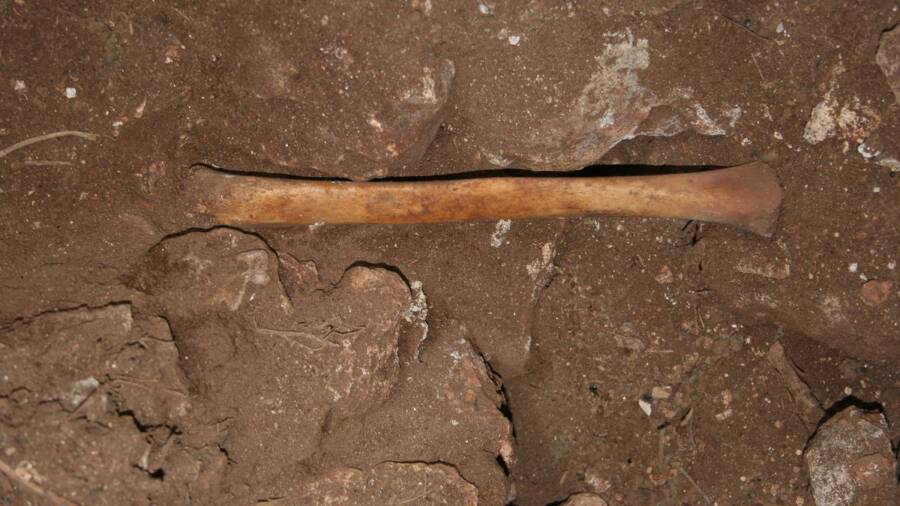Researchers found evidence of ancient humans modifying the bones of the deceased, but the exact purpose of this practice remains a mystery.

J.C. Vera RodríguezThe entrance to Marmoles Cave, where researchers discovered modified ancient human bones.
Ancient humans in Spain manipulated and reused the bones of the deceased for a variety of purposes, including tools and dinnerware, according to a new study.
The findings, published in the journal PLOS One, focus on remains discovered in the Cueva de los Marmoles in southern Spain’s Andalusia region.
The archaeologists studying the specimens said that one human shinbone had been used as a tool of sorts and that one human skull had been modified for use as a drinking cup.
The researchers noted that these findings show how the relationship between the living and the dead fundamentally impacted ancient human culture.
The remains were dated to roughly between the fifth and second millennia B.C.E, and evidence suggests that the individuals were placed inside cave while only partially decomposed.
“At Marmoles cave we identified various types of modification and manipulation of human skeletal remains. These can be grouped into smashing and fracturing the bones, as well as their apparent cleaning from residual soft tissues,” researchers told Newsweek.
Researchers noted that some modifications — particularly fractures and scrapes — may have been made in attempts to extract bone marrow as a cannibalistic ritual, though it may have also just been for nutrition.
Previous studies have shown that ancient humans regularly used caves across the region as burial sites, most commonly around the fourth millennium B.C.E. Evidence has also shown other examples of ancient humans manipulating remains, but the cultural meaning of this practice is unclear.
In Marmoles Cave alone, researchers documented at least two instances of long human bones being reworked into scraping tools. It was also here that they made their most “intriguing” discovery: a human cranium refashioned into a “skull cup.”

Photographs by Z. Laffranchi, CT images by M. MilellaThe “skull cup” discovered in Marmoles Cave.
“All finds from Marmoles are quite interesting since they document complex—and for us still largely puzzling—beliefs and concerns regarding death, and the relationship between the dead and the community of the living,” the researchers said. “The skull-cup is one of the most striking examples of this complex relationship between the living and the dead. It is a carefully modified human skeletal part.”
However, researchers are still uncertain about the use, symbolic value, and social relevance of this skull cup. They do know that the cup was made from a cranium belonging to a man between the ages of 35 and 50 — and that while he was alive, it’s possible he underwent a trepanation procedure.
Trepanation is a practice that involves drilling or scraping a hole into a human’s skull. In some instances, this was used as a medical intervention, but many ancient societies also performed trepanation for religious or ritual purposes.
So far, though, researchers have not been able to determine if the trepanation has any direct link to the creation of the skull cup.
There are, unfortunately, still a lot of unknowns with the Marmoles Cave discoveries. Who performed the body modifications? What was the purpose? What was the symbolic meaning of doing so?

J.C. Vera RodríguezThe cave was used as a burial site by various groups of prehistoric people for several millennia.
The researchers did offer up a few different theories. They said that members of these ancient communities likely carried out the modifications as part of a funerary service. In that case, these behaviors may have been seen as a way to mediate the transition between the realms of the living and the dead.
Evidence at other cave sites in the Iberian Peninsula shows that the practice was fairly widespread, although the true purpose of these complex funerary behaviors remains a mystery.
“Zooming out and putting Marmoles cave in the broader context of Andalusia and Southern Spain, we can detect various similarities with other published cave contexts, in the type of traces and modifications of the bones as well as in their overall managing. This is quite interesting and points to shared ideologies surrounding death, the dead, and their physical remains,” the researchers said.
After learning about this ancient funerary practice, read about the prehistoric cannibalized remains that were identified as an 11-year-old girl. Then, read about a more disturbing practice of body modification: the taking of human trophies from fallen Japanese soldiers by the Americans during World War II.





